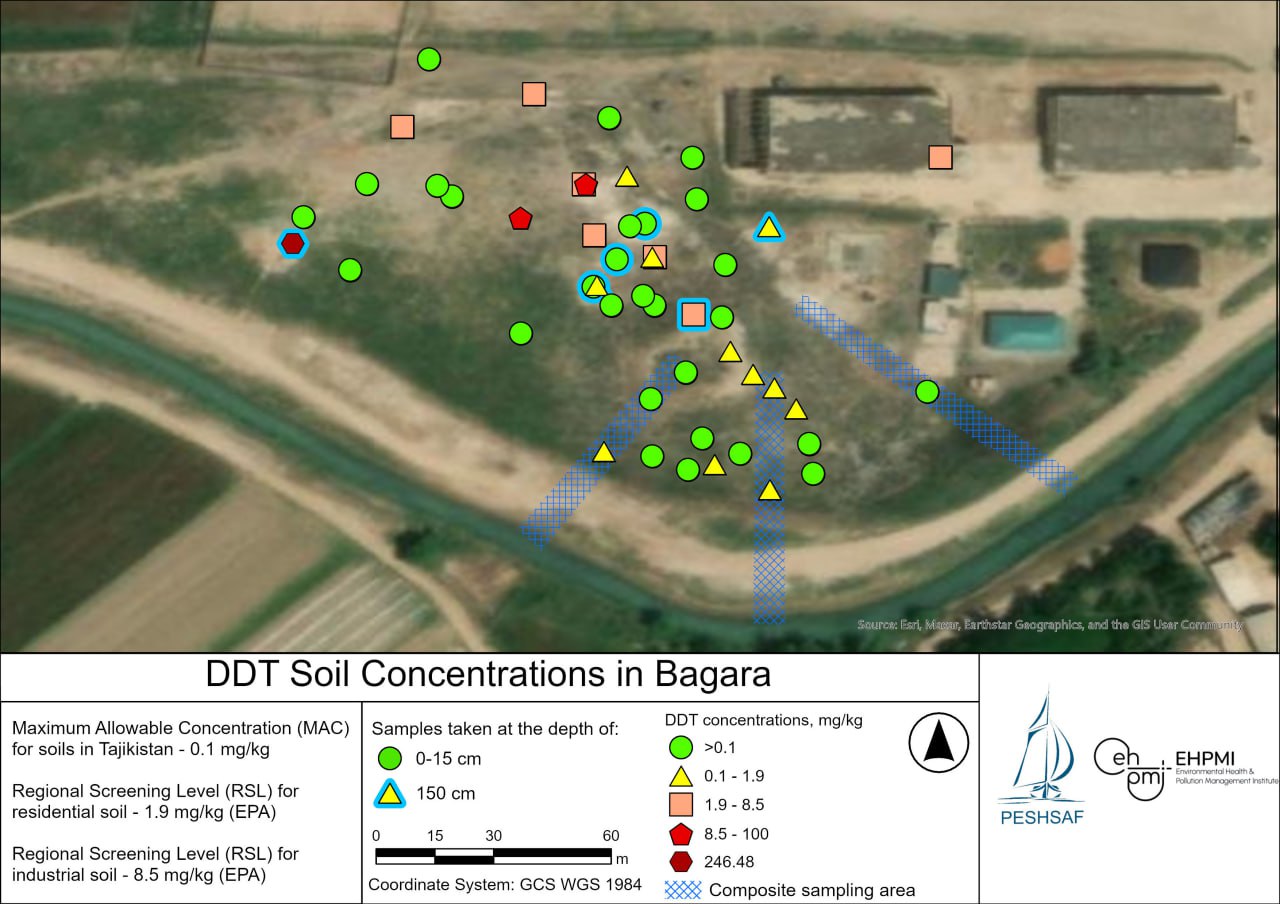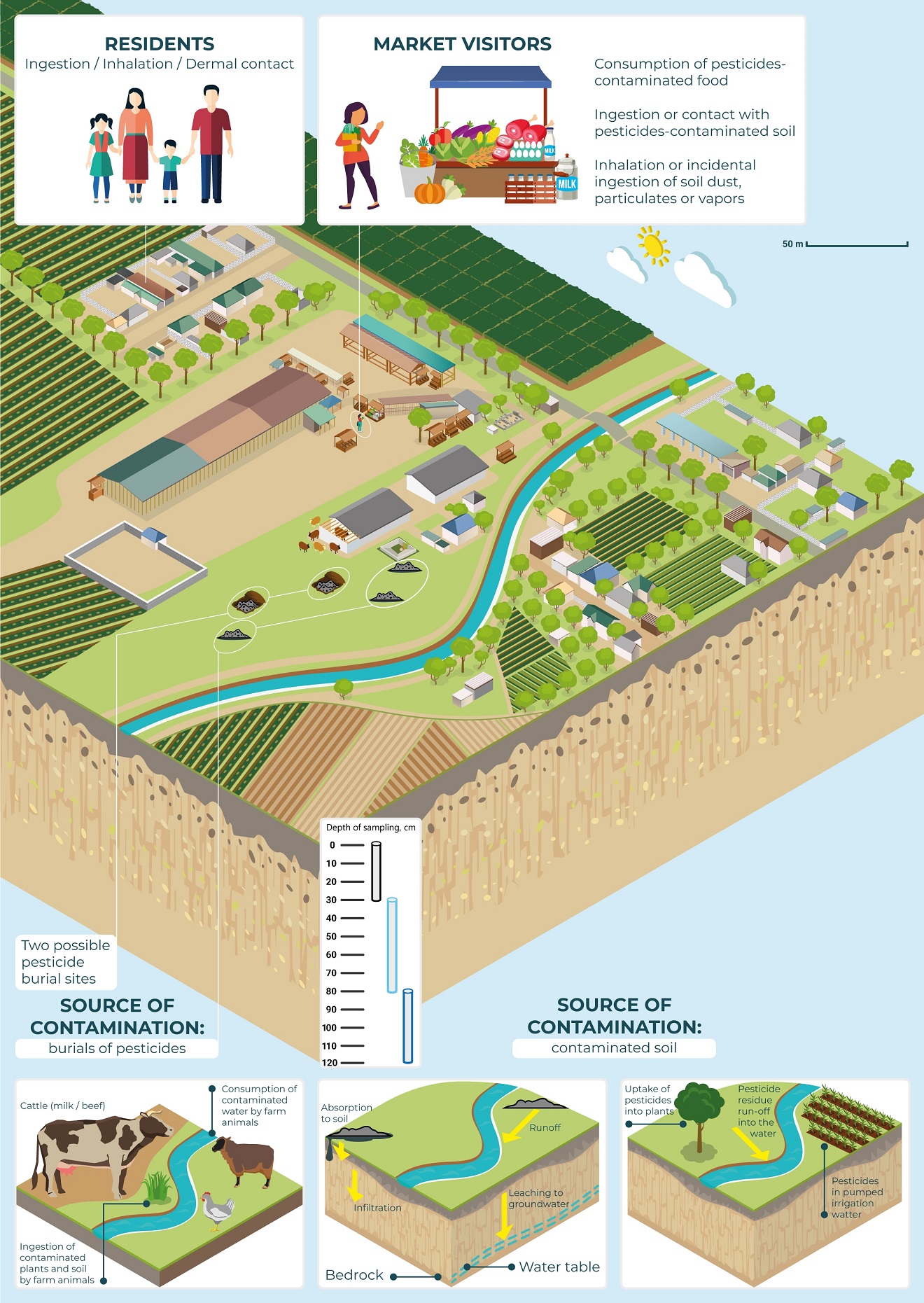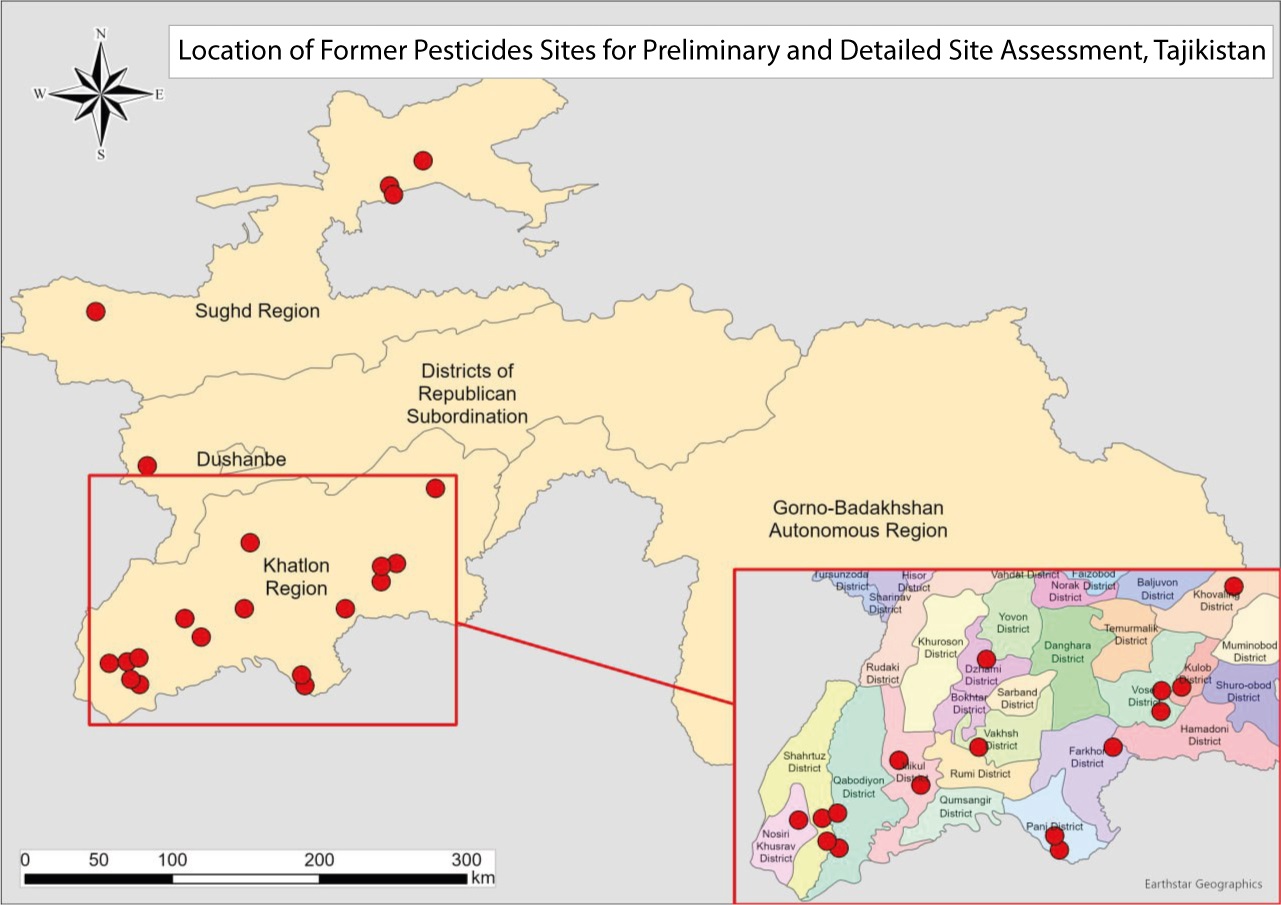Detailed and Rapid Environmental Assessments of Sites Contaminated with Obsolete Pesticides in Tajikistan, 2023-2024
Project dates: 2023-2024
Number of people at risk: 15,000 residents
Source of pollution: Burials of obsolete pesticides, DDT
Project implementers: CSO “Peshsaf”, EHPMI, Environmental Protection Committee
Total cost: 100,000 USD; the project was funded by FAO/GEF.
The project was implemented in 2023-2024 by EHPMI-Peshsaf with the financial and organizational support of FAO UN and the Environmental Protection Committee under the Government of the Republic of TajikistanProject dates: 2023-2024Number of people at risk: 15,000 residentsSource of pollution: Burials of obsolete pesticides, DDTProject implementers: CSO “Peshsaf”, EHPMI, Environmental Protection CommitteeTotal cost: 100,000 USD; the project was funded by FAO/GEF.
As part of the GEF/FAO project “Lifecycle Management of Pesticides and Disposal of POPs Pesticides in Central Asian countries and Türkiye” Peshsaf/EHPMI conducted 20 Rapid Environmental Assessments (REA) and one Detailed Site Assessment (DEA).
Detailed Site Assessment of Bagara Bazaar
The project team investigated Bagara Bazaar in Peshkadam Village, 20 Years of Independence Jamoat, Vakhsh District. The site is located in rural area of Khatlon Region in the south of Tajikistan. The conducted assessment corresponds to Tool P (Preliminary risk assessment and detailed site investigation design) of FAO Environmental management tool kit for obsolete pesticides (EMTK).
The results of the DSA confirmed that the site is contaminated with highly toxic obsolete pesticides, mainly 1,1,1-trichloro-2,2-bis(p-chlorophenyl) ethane (DDT). The list of secondary contaminants includes toxic substances that contaminate commercial preparations of DDT or result from chemical transformation of DDT in soil, such as DDE (1,1-dichloro-2,2-bis(p-chlorophenyl) ethylene) and DDD (1,1-dichloro-2,2-bis(p-chlorophenyl) ethane). Some other obsolete pesticides were also found at the site, including: lindane with the highest concentration of 1,507 mg/kg and endosulfan with the highest concentration of 372 mg/kg.
The national standard for DDT (Maximum Allowable Concentration – MAC) in Tajikistan is 0.1 mg/kg and the United States Environmental Protection Agency (USEPA) Regional Screening Level (RSL) for DDT in residential soil is 1.9 mg/kg. At this site the soil DDT concentrations ranged from 0 to 246.48 mg/kg and the average concentration was 7.34 mg/kg. The concentrations of DDT exceeded the baseline values of Tajikistan (0.1 mg/kg) in 43% of the analyzed samples, reaching 2,465 MAC. The USEPA RSL for residential soil (1.9 mg/kg) was exceeded in 20% of the samples. The RSL for industrial soils was exceeded in 6% of the samples.
The project team also assessed the area for heavy metals contamination, paying particular attention to lead, arsenic, mercury, uranium, copper and zinc. The maximum arsenic concentrations in all soil samples exceeded both the MAC (2 mg/kg) established for soils in Tajikistan and the RSL for soils in residential (0.68 mg/kg) and industrial (3 mg/kg) areas 17, 49 and 11 times respectively.
The main sources of contamination are two warehouse buildings with residues of toxic chemicals inside, burials of pesticides and the contaminated soil around them. The main contaminants are: DDT, its derivatives, other organochlorine pesticides, and arsenic. Now, human exposure is possible, mainly through inhalation of dust and vapors and dermal contact. The presence of DDT and other contaminants may limit or prevent the use of the area for agriculture or housing construction.
As part of the DSA process, the project team met with heads (hakims) of District Administrations and local administrations to discuss the findings and feasibility of risk reduction activities. The local administrators expressed support for the assessment activities and promised to help with the coordination and implementation of the future risk reduction measures. The project team also interviewed local residents to find out about the contamination distribution patterns and known health impacts.
Extensive sampling conducted as part of DSA allowed to estimate the volumes of contaminated materials and propose risk reduction alternatives. The area contaminated with DDT and other pollutants is about 480 square meters and the volume of contaminated soil and pesticides is estimated 400 cubic meters. The project team has discussed the findings with the Committee of Nature Protection and identified physical removal of the contaminated materials and relocation to Vakhsh Polygon as the priority cleanup option.



| Location | Description | DDT concentration |
| Tajikistan, Khatlon region, Shaartuz District,Jamoat H. Kholmatov | The warehouse building is abandoned now. The walls and ground are contaminated with pesticides, especially DDT. | 2731 |
| Tajikistan, Sughd region, Penjikent district, Jamoat Loik Sharoli | Despite the fact that the warehouse premises have been renovated and the area has been cleaned, there is a very strong smell of pesticides on the site. The main pollutant is DDT. | 1545 |
| Tajikistan, Sughd region, Gafurovsky district, Jamoat Isfisor | The suspected source of contamination is wind-borne pesticides. | 1000 |
| Former pesticides warehouse of Azizov, Hiztevarz Jamoat, Gafurov District | The facility is located in Khiztevarz jamoat B. Gafurov district, Sogd region. The suspected source of pollution is pesticides, which are transmitted by wind | 1000 |
| Tajikistan, Sughd region, Gafurovsky district, Jamoat Hiztevarz | The facility is located on the territory of Ismoil B. jamoat, Gafurov district, Sughd region. The suspected source of contamination is pesticides. | 1000 |
| Tajikistan, Khatlon region, Nosiri-Khusrav district, Jamoat Bakhor | A former pesticides warehouse is located in Bakhor Jamoat, Nosiri-Khursav District, Khatlon Region. Only walls and some iron-concrete connections remain of the building. There are yellow and white colored spots on the ground. | 634 |
| Tajikistan, Khatlon region, Vose district, Jamoat Tugarak | The former pesticide warehouse is located on the Tomin state farm in the village of Sulkhobod. Pesticide residues mix with the soil. | 234 |
| Tajikistan, Khatlon region, Pyanj district, Jamoat Vahdati Milli | The main pollutant is DDT. In the 1990s, several tons of pesticides were buried at this site. | 190 |
| Tajikistan, Khatlon Region, Farkhor District,Jamoat Dekhkon Aryk | The warehouse area is not fenced and people have free access. People use the warehouse building to store firewood. The main pollutant is DDT. | 161 |
| Tajikistan, Khatlon region, Dusti District, Jamoat Jilikul | The pesticide burial site is located in the cotton field of the E. Sultonov farm in the Jilikul jamoat. Traces of pesticides were found on the surface of the burial. The smell of pesticides is very strong. | 129 |
| Tajikistan, Khatlon region, Pyanj district, the facility is located 7 km. from the jamoat itself S. Kabutov | Standard warehouse DHF, former village of Rokhi Lenin: The facility is located 7 km from the jamoat itself. The suspected source of contamination is DDT, Chromium. | 123,1 |
| Tajikistan, Khatlon region, Dusti District, Jamoat Jamoat 20 years of Independence | The former warehouse of pesticides is located in Mekhnatobod village of the Jamoat 20 years of Independence. Only partially destroyed walls remain from the warehouse building. The main pollutant is DDT. | 76 |
| Tajikistan, Khatlon region, A. Jami district, Jamoat Giyosov | The former warehouse is located in Ozodii Shark Village, Giyosov Jamoat, Lami District, Khatlon Region. The pesticide contamination is visible on the ground. There is strong chemical odor at the site. | 76 |
| Tajikistan, Khatlon region, Vose district, Jamoat Vaysov | The main pollutant is DDT. | 62,8 |
| Tajikistan, Khatlon region, Shaartuz District, Jamoat T. Sadriddinov | The pesticide burial site is located in the village of Lolazor, Jamoat T. Sadriddinov, Shaartuz district. The main source of pollution is DDT. | 62 |
| Tajikistan, Khatlon region, Kabadiyansky district, Jamoat “20 solagia Istikloliyat” | The former warehouse of toxic chemicals is located in the village of Doki, jamoat “20 solagii Istikloliyat” of the Kabadiyansky district. The warehouse was completely destroyed, but there are still remains. Very polluted area. | 47,3 |
| Tajikistan, Khatlon region, Kubodiyon district, Jamoat Navobod | The former pesticide storage is located in Kubodiyon District, Navobod Jamoat, Dehkan farm “Ibod”. The main contaminant is DDT. | 34,5 |
| Tajikistan, Khatlon region, Kulob city, Jamoat Kulob | The warehouse of obsolete pesticides is located in the lower part of the city of Kulob, in the jamoat of Kulob, Lagmon. The main source of pollution is DDT. | 34,4 |
| Tajikistan, Regions of Republican Subordination, Tursunzade city, Jamoat Seshanbe | The former warehouse of pesticides is located in Tursunzade Village, Seshanbe Jamoat. The main pollutant is DDT. There are bags with pesticides outside the warehouse. | 30,7 |
| Tajikistan, Khatlon region, Khovaling district, Jamoat Hovaling | The former pesticide warehouse is located in the Tutak village of Khovaling jamoat. In 2016, people built their houses very close to the contaminated area. The main source of pollution is DDT. | 8,76 |
DDT – General Information
The term DDT refers to p,p’-dichlorodiphenyltrichloroethane. DDT, prepared by the reaction of chloral with chlorobenzene in the presence of sulfuric acid, was first made in 1874; and its insecticidal properties were discovered in 1939 by a Swiss chemist, Paul Hermann Müller. DDT (dichloro-diphenyl-trichloroethane) is considered one of the first of the modern synthetic insecticides.
DDT is applied as a dust or by spraying its aqueous suspension. The term DDT is also applied to commercial products consisting predominantly of p,p‘-DDT, but also containing smaller amounts of other compounds. All DDT isomers are tasteless, almost odorless solids.
Major uses of DDT
DDT is a non-systemic contact insecticide with a broad spectrum of activity. Growers used DDT on a variety of food crops in the United States and worldwide. Some of the crops were beans, cotton, soybeans, sweet potatoes, peanuts, cabbage, tomatoes, cauliflower, brussel sprouts, corn, and other crops. DDT was also used in buildings for pest control.
It was banned in several countries in the early 1970s because of ecological considerations, and many other countries have more recently restricted or banned its use except when it is needed for the protection of human health. Despite a ban on sales, organochlorines may still be found in storage in many countries such as Tajikistan; thus, exposure is still possible. DDT is still used in some countries for the control of vectors that transmit yellow fever, sleeping sickness, typhus, malaria and other insect-transmitted diseases.
DDT Persistence
DDT was designated as a persistent organic pollutant (POP) in 1997 by the Governing Council of the United Nations Environment Programme. Pesticide applicators are exposed primarily to p,p‘-DDT, whereas it is the p,p‘-DDE metabolite to which the general population is exposed in the diet or drinking-water.
DDT and its metabolites are persistent in the environment and resistant to complete degradation by microorganisms, although photochemical degradation does occur. The persistence of DDT is substantially lower in tropical climates than in temperate ones (a few months compared with years). DDT and its metabolites are readily adsorbed onto sediments and soils, which can act both as sinks and as long-term sources of exposure. Because of its strong tendency to be adsorbed onto surfaces, most DDT that enters water is and remains firmly attached to soil particles. If it does find its way into water, it is gradually lost by adsorption onto surfaces.
In soils, DDT is immobile under aerobic conditions with a mean half-life ranging from 2 to 15 years. DDT is metabolized by microbial systems in soils and is broken down into DDE and DDD. Significant degradation has been demonstrated in soils under anaerobic conditions, while little or no degradation was observed under aerobic conditions. Biodegradation, however, is highly variable and influenced by the populations of required microorganisms. Various amendments to soils such as energy and carbon sources, were shown to increase degradation under anaerobic but not aerobic conditions. DDT has been shown to readily degrade in certain flooded soils. DDT is apparently co-metabolized by microorganisms and is not used as a sole carbon source. Products of biodegradation include DDD and DDE and occasionally DBP (4,4′-dichlorobenzophenone).
The physical and chemical properties of DDT and its metabolites enable these compounds to be taken up readily by organisms from the surrounding medium and from food. In aquatic organisms, uptake from water is generally more important, whereas food is the major source for terrestrial fauna. High lipid solubility and low water solubility lead to the retention of DDT and its stable metabolites in fatty tissue. In general, organisms at higher trophic levels tend to contain more DDT-type compounds than those at lower ones. These compounds can be transported around the world in the bodies of animals, as well as in ocean and air currents.
In the United States, populations of bald eagles and other raptors crashed when DDT thinned their eggs, killing their embryos. The pesticide, known for accumulating in food webs and persisting in soil and river sediment, was banned in the United States in 1972. Studies in animals have also shown that oral exposure to DDT can cause liver cancer.
DDT is classified as “moderately toxic” by the US National Toxicology Program (NTP) and “moderately hazardous” by WHO, based on the rat oral LD 50 of 113 mg/kg. Indirect exposure is considered relatively non-toxic for humans. The International Agency for Research on Cancer (IARC) classified DDT as Group 2A “possibly carcinogenic to humans”. EPA has determined that DDT, DDE, and DDD are probable human carcinogens as of January, 2015.
Current concerns surrounding DDT are that it is an endocrine disruptor. Endocrine disruptors are chemicals that can interfere with endocrine (or hormone) systems at certain doses. These disruptions can cause cancerous tumors, birth defects, and other developmental disorders. Any system in the body controlled by hormones can be derailed by hormone disruptors. A wide and varied range of substances are thought to cause endocrine disruption. Chemicals that are known endocrine disruptors include diethylstilbestrol (the synthetic estrogen DES), dioxin and dioxin-like compounds, polychlorinated biphenyls (PCBs), DDT, and some other pesticides.
Pesticides in Tajikistan
Before the collapse of the Soviet Union, pesticides and other chemicals were actively used in Tajikistan’s agriculture. The application of different pesticides was often done without proper adherence to the existing rules and standards and without consideration of the climatic conditions in different areas.
The range of pesticides used in Tajikistan included the following POPs: aldrin, dieldrin, heptachlorine, endrin, hexachlorinebenzene, toxaphene, chlordane, DDT, endosulphane, and lindane. On average, about 14 thousand tons of pesticides were brought to Tajikistan every year. The share of DDT constituted from 33 to 80% of the total volume of pesticides. About 90 thousand tons of DDT were brought to Tajikistan during the period of active use of this insecticide.
In 1970, by the decree of the Minister of Health of the Soviet Union, application of DDT was banned in agriculture and, in 1987. DDT was banned for use to control vector-borne diseases. In the 1980s and through the beginning of 1990s, the use of other pesticides-POPs was also banned. Despite the ban, the remaining pesticides were still used, though in much smaller volumes.
Currently, the threat of obsolete pesticides to the health of people and the environment in Tajikistan still exists. During the Soviet time, the amount of pesticides brought to Tajikistan exceeded actual application needs by 1.5-2 times. As a result, excessive volumes of pesticides were accumulating in multiple storages and distribution centers of “Tajikselkhozkhimiya” Republican Service. Because there were so large volumes of unused pesticides, various violations occurred: pesticides were distributed to individuals for uncontrolled use in their gardens, some pesticides were dumped in municipal landfills or secretly buried. In the 2000s and because of small supplies of pesticides to Tajikistan, the existing volumes of obsolete pesticides were used again in agriculture. People particularly preferred using DDT and excavated the waste chemical from the Vakhsh polygon, where more than 9 thousand tons of DDT were buried. The customs of Tajikistan registered some cases of illegal import of DDT, including the case of bringing 7 tonnes of DDT from Uzbekistan.
Today, agriculture is an important part of Tajikistan economy, generating about 24.2% of GDP (2015). The total area of land used for growing various crops exceeds 900 thousand hectares. Much attention was also paid to the agricultural sector while Tajikistan was part of the USSR. In Tajikistan there were significant areas of agricultural land for growing crops, especially cotton, and millions of rubles were spent on building infrastructure, as well as providing the industry with agrochemicals and pesticides. The development of agriculture, and, above all, cotton growing, in Tajikistan was closely linked to the widespread use of pesticides to control agricultural pests, plant diseases, and weeds.
